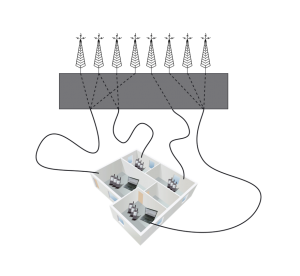- Emulates all relevant effects of signal strength in the lab
- Virtual drive tests to evaluate network set ups and UE performances
- Deployable for self-organizing network (SON) optimization
 The QPER Handover Tester provides engineers with a platform to test all relevant signal strength effects on the radio channel.
The QPER Handover Tester provides engineers with a platform to test all relevant signal strength effects on the radio channel.
The QPER hardware interconnects base stations or (e)NodeBs with test UEs by digitally controllable attenuators. RF signals are transmitted through coaxial cables. Each signal path can be attenuated individually in steps of 1 dB. The system dimension is very flexible: it can be selected between variants with 1 to 16 ports on both sides.
Model signal strength by virtual drive tests
 The unique advantage of QPER is its virtual drive test software control, a very intuitive and real-life like method to outline network layout and a drive test route on the screen. This allows testers to model all propagation effects relevant for signal strength, such as path loss, signal drops caused by fast-fading or shadowing.
The unique advantage of QPER is its virtual drive test software control, a very intuitive and real-life like method to outline network layout and a drive test route on the screen. This allows testers to model all propagation effects relevant for signal strength, such as path loss, signal drops caused by fast-fading or shadowing.
These features enable engineers to emulate handover scenarios to verify network set-ups and test UE performance and interoperability with network components.
Replay drive tests for reproducible network conditions
Signal strength information can alternatively also be extracted from previously recorded drive tests. QPER supports the import of drive test data from various drive testers, such as Anite NEMO or Rohde & Schwarz ROMES drive tester. With this application, drive tests can be exactly repeated on the attenuator matrix and network conditions causing failure become reproducible in the lab.
Deployable for SON
By forcing networks to induce handovers automatically and unattended over a long duration, the QPER Handover Tester is perfectly suited to verify the algorithms of self-organising networks (SON). This utilization may further refined by combining QPER with LTS Mobile Network Tester, where call genaration with real UEs can be automated and synchronized with the mobility simulation.
To simulate MIMO-effects an extension is availabe: the QPER MIMO-Tester.
In a reduced variant, QPER can also be used as an electronic RF switch to supply test signals to various test rooms within a test lab. A multi-user concept gives every tester an easy overview about the resources in use. There is no need for a manual patch panel, any fixed value attenuators and RF combiners. Thus, QPER helps lab administrators to manage the lab resources and users.
Technical Data
- Frequency range:
500 – 3000 MHz (standard version),
500 – 6000 MHz (extended version) - Eubus 380 MHz – 3.0 GHz Solid State Programmable Attenuator (standard Version), or
Eubus 700 MHz – 6.0 GHz Solid State Programmable Attenuator (extended Version) - Impedance: 50 Ω
- Customizable dimensions from 2 x 1 up to 16 x 16 RF ports
- Dynamic attenuation range: 0 – 95.5 dB
- Attenuation steps: 0.5 dB
- Number of switches: > 4000 / sec, real time, up to 128 parallel settings (i.e. up to 512.000 HW settings per second)
- Max. input power: + 23 dBm
- RF-connectors: N(f) or SMA(f), front- and/or rear side mounted
- Operating system: Windows XP, Vista or 7
- Path loss propagation models:
Free space path loss
Okumura-Hata model
Walfisch-Ikegami model
Kathrein antenna patterns - Fading effects on signal strength:
Rayleigh Fading (NLOS model)
Rician Fading (LOS models) - Drive test file formats:
Rohde & Schwarz ROMES Drive Tester ASCII format
Anite NEMO open file format
MEDAS general file format
